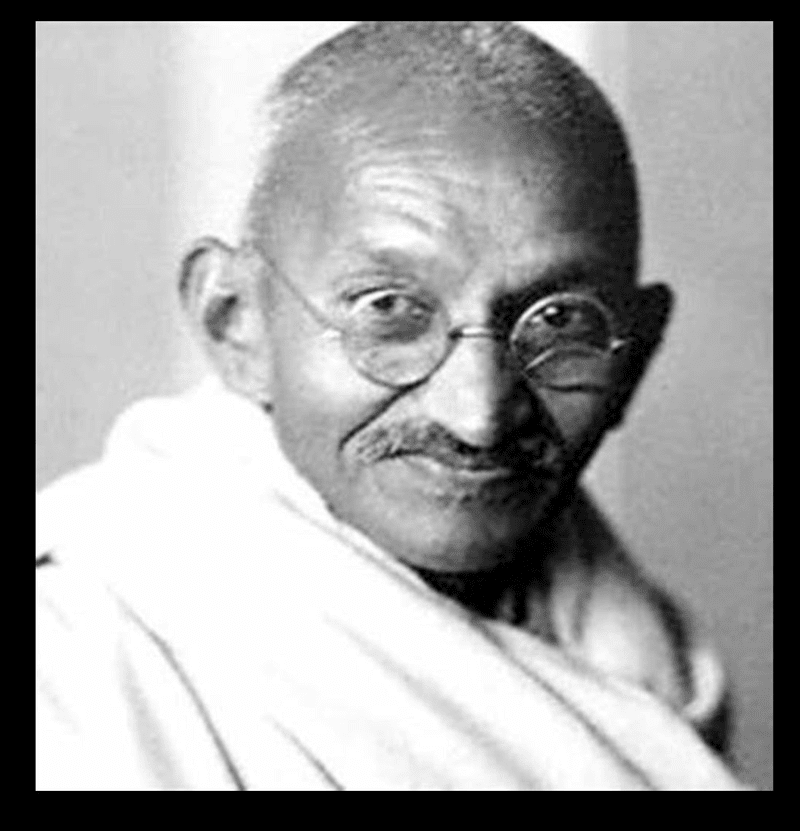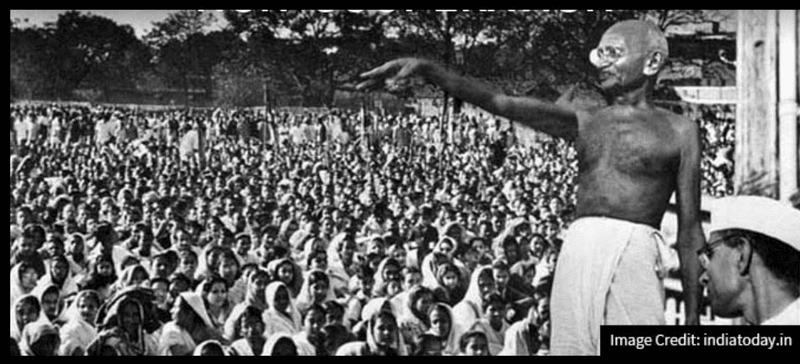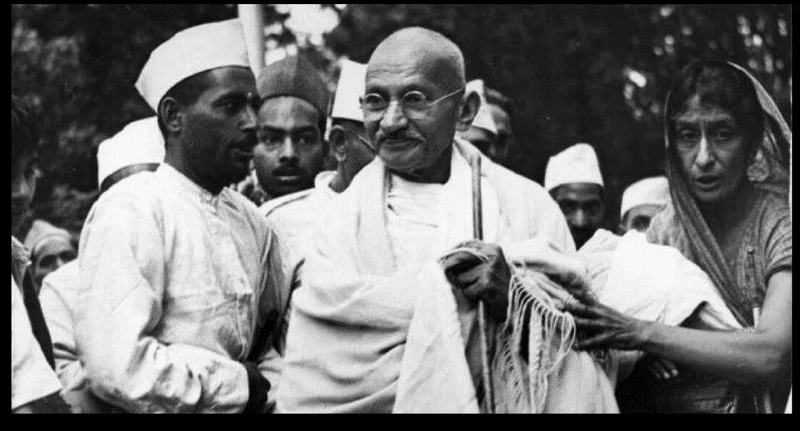GS1 - History
The Gandhian Era, spanning from the early 1910s to 1947, was a pivotal period in India's struggle for independence.
It was characterized by the leadership and principles of Mohandas Karamchand Gandhi, known as Mahatma Gandhi. During this time, India witnessed several mass movements such as the Non-Cooperation Movement, Civil Disobedience Movement, and Quit India Movement. These movements, rooted in Gandhi's philosophy of nonviolent resistance (Satyagraha) and civil disobedience, played a pivotal role in challenging British colonial rule. Gandhi's emphasis on truth, justice, and nonviolence became the driving force behind the Indian freedom movement, eventually leading to India's independence in 1947.
About Mohandas Karamchand Gandhi

Mahatma Gandhi, born on October 2, 1869, in Porbandar, India, played an extraordinary role in India's struggle for independence from British colonial rule. He was not just a political leader but a profound philosopher whose life and actions were deeply rooted in certain values and principles.
Gandhi's core philosophy revolved around non-violence or "Ahimsa," and he believed it was the most potent weapon for oppressed people to achieve social and political change. He coined the term "Satyagraha," which means the "truth force," advocating non-violent resistance based on truth and moral authority.
Gandhi's philosophy also encompassed self-reliance, simplicity, and communal harmony. He urged Indians to boycott British institutions during the Non-Cooperation Movement (1920-1922) and launched the Civil Disobedience Movement in 1930, symbolized by the famous Dandi March. In 1942, he initiated the Quit India Movement, demanding an immediate end to British colonial rule, marking a turning point in the struggle for independence.
Gandhi's values included equality, secularism, self-discipline, and service to others. His imprisonment, hunger strikes, and leadership in the Indian National Congress were pivotal in the fight for freedom. Gandhi's famous sayings like "An eye for an eye only ends up making the whole world blind" and "The best way to find yourself is to lose yourself in the service of others" continue to inspire people worldwide. His legacy is a symbol of moral and political courage in the quest for peace, justice, and civil rights.
Some famous movements led by Gandhi
1. Non-Cooperation Movement

The Non-Cooperation Movement was a significant phase in India's struggle for independence from British colonial rule. It was initiated by Mahatma Gandhi, one of the key leaders of the Indian independence movement. Here is a detailed overview of the Non-Cooperation Movement:
Background:
- The Jallianwala Bagh massacre of 1919, where British troops opened fire on a peaceful gathering in Amritsar, killing hundreds, was a turning point in India's struggle for freedom.
- The dissatisfaction with the repressive Rowlatt Act, which allowed for the arrest and detention of Indians without trial, further fueled anti-British sentiments.
Initiation and Launch:
- The Non-Cooperation Movement was formally launched on August 1, 1920, during the special session of the Indian National Congress at Calcutta.
- Mahatma Gandhi, who had returned from South Africa and had already become a prominent leader in the Indian National Congress, played a pivotal role in advocating for non-cooperation with British authorities.
Aims and Objectives:
- The movement aimed to protest against British colonial rule and demand swaraj (self-rule) for India.
- It aimed to achieve these objectives through non-violent, non-cooperation with the British government and its institutions.
Methods and Strategies:
- Gandhi advocated the use of non-violent civil disobedience, including boycotts, hartals (strikes), and non-participation in British-run institutions.
- Indians were encouraged to boycott British-made goods, courts, schools, and government positions.
- People were urged to work towards self-sufficiency by promoting the use of khadi (handspun and handwoven cloth) and the charkha (spinning wheel).
- Mass mobilization and mass protests were organized across the country.
Key Events and Phases:
Chauri Chaura Incident (1922): The movement faced a setback when a violent clash occurred in Chauri Chaura, Uttar Pradesh. Gandhi, deeply troubled by the incident, called off the Non-Cooperation Movement as he believed it had taken a violent turn, which was against the principles of non-violence.
Results and Impact:
- The Non-Cooperation Movement had several significant outcomes and long-term impacts:
- It demonstrated the power of non-violent civil disobedience as a tool for achieving political change.
- It marked a significant shift in Indian politics as it brought millions of common people into the political arena.
- It led to the growth of the Indian National Congress and established Gandhi as a mass leader.
- The British government had to address some Indian grievances. The Montagu-Chelmsford Reforms and the Government of India Act of 1919 aimed to address some of these concerns.
The Non-Cooperation Movement was a pivotal phase in India's struggle for independence, driven by Mahatma Gandhi's principles of non-violence and non-cooperation. Despite its suspension due to the Chauri Chaura incident, the movement left a lasting impact on India's quest for self-rule, inspiring further civil disobedience campaigns and strengthening the resolve of the Indian people in their fight against British colonialism.
2. Civil Disobedience Movement

The Civil Disobedience Movement was another significant phase in India's struggle for independence, marked by non-violent resistance and mass non-cooperation with the British colonial authorities. Here's a detailed overview of the Civil Disobedience Movement, which followed the Non-Cooperation Movement:
Background:
- The Civil Disobedience Movement was initiated in 1930, primarily in response to the oppressive policies and taxes imposed by the British colonial government.
- It came after the failure of the Simon Commission and the First and Second Round Table Conferences to address Indian demands for self-rule.
Initiation and Launch:
- The movement was formally launched on March 12, 1930, with the famous Dandi Salt March. Mahatma Gandhi led a group of protesters on a 240-mile march from Sabarmati Ashram to the Arabian Sea to make salt from seawater in defiance of the British monopoly on salt production and taxation.
Aims and Objectives:
- The primary aim was to demand complete independence from British rule (Purna Swaraj).
- The movement also protested against various unjust British laws, taxes, and restrictions, especially the salt tax.
Methods and Strategies:
- The key strategy was non-violent civil disobedience, which included non-cooperation with the British authorities, boycotts, protests, and mass demonstrations.
- The making and selling of salt by individuals without paying the salt tax became a symbol of resistance.
- People were encouraged to refuse to pay taxes, participate in the boycott of British goods, and support the indigenous production of salt and other essential commodities.
Key Events and Phases:
- Dandi Salt March (March-April 1930): Gandhi's march to the Arabian Sea to make salt was a symbolic act of civil disobedience and marked the beginning of the movement.
- Dharasana Salt Works (May 1930): A significant non-violent protest took place at the Dharasana salt works in Gujarat, where protesters were met with brutal police violence.
- Round Table Conference (1930-1932): Gandhi and other leaders were invited to participate in the Second Round Table Conference in London, but the discussions failed to yield results.
- Gandhi-Irwin Pact (1931): An agreement was reached between Mahatma Gandhi and the Viceroy, Lord Irwin, leading to the suspension of the civil disobedience campaign.
Results and Impact:
- The Civil Disobedience Movement had several important outcomes:
- It gained international attention and put significant pressure on the British government to address Indian demands.
- It led to the Gandhi-Irwin Pact, which allowed for the release of political prisoners and initiated discussions on Indian self-rule.
- It inspired further movements and civil disobedience campaigns, strengthening India's resolve for independence.
The Civil Disobedience Movement, with its central focus on non-violent civil disobedience and non-cooperation, played a crucial role in the broader struggle for Indian independence. It demonstrated the power of mass mobilization and non-violence as tools for political change, which continued to shape India's path towards self-rule.
Varied responses across the nation
During the Salt Satyagraha, India witnessed a diverse response in different regions. Tamil Nadu, led by C. Rajagopalachari, witnessed salt marches, picketing of foreign cloth shops, and anti-liquor campaigns. In Malabar, Kelappan organized salt marches. Andhra Region had district salt marches and military-style camps as their centers. Bengal experienced the highest number of arrests and significant violence, with movements around salt satyagraha and chaukidari tax protests. Bihar initiated salt satyagraha but later shifted to non-chaukidari tax agitation due to production constraints. Peshawar stood out for Khan Abdul Gaffar Khan's 'Khudai Khidmatgars.' Dharasana Salt Works raid led by Sarojini Naidu, Imam Sahib, and Manilal Gandhi was met with police brutality. In the United Provinces, no-revenue and no-rent campaigns challenged the government.
3. Quit India Movement

The Quit India Movement, also known as the August Movement or the August Kranti, was a pivotal episode in India's struggle for independence. Here's a comprehensive overview of the Quit India Movement:
Background:
- The Quit India Movement was initiated in response to the failure of the Cripps Mission (1942) and the British reluctance to concede full independence to India.
- It was a spontaneous mass protest against British colonial rule.
Initiation and Launch:
- The movement was officially launched on August 8, 1942, at the Bombay session of the All-India Congress Committee (AICC).
- Mahatma Gandhi gave the famous "Quit India" speech, urging the British to leave India immediately and calling for mass non-violent civil disobedience.
Aims and Objectives:
- The primary aim was the immediate end of British colonial rule and the establishment of an independent Indian government.
- It aimed to secure the support of Indians from all walks of life in the struggle for freedom.
Methods and Strategies:
- Non-violent civil disobedience was the primary strategy, and protesters were encouraged not to resort to violence.
- Key methods included non-cooperation, strikes, demonstrations, and non-payment of taxes.
- There was a call for the disruption of British government machinery and the obstruction of communication and transportation.
Key Events and Phases:
- Arrest of Key Leaders: Soon after the launch of the movement, many prominent leaders, including Gandhi, were arrested.
- Spread of Protests: The movement spread across the country, with people participating in mass demonstrations and civil disobedience.
- "Do or Die" Call: Mahatma Gandhi gave the "Do or Die" call, urging people to be ready for any sacrifice in the struggle for freedom.
- Repression: The British authorities responded with force, leading to widespread arrests and violent clashes in some regions.
- End of World War II: The movement coincided with the end of World War II, and international pressure on Britain to address India's demands increased.
- Cabinet Mission (1946): Post-Quit India, the British government sent the Cabinet Mission to India to discuss a new constitutional framework, ultimately leading to the framing of the Indian Constitution.
Results and Impact:
- The Quit India Movement marked a turning point in India's struggle for independence. Although it was met with harsh repression, it strengthened the resolve of Indians to fight for freedom.
- It led to international attention and sympathy for the Indian cause.
- The movement paved the way for negotiations that eventually led to the transfer of power and the establishment of independent India in 1947.
Conclusion
The Quit India Movement, with its emphasis on non-violence and mass civil disobedience, played a critical role in hastening the end of British colonial rule in India. It highlighted the determination and unity of the Indian people in their quest for independence. Ultimately, the relentless efforts of Gandhi and other freedom fighters led to India gaining its independence from British colonial rule on August 15, 1947.
This historic moment, marked by the midnight "Tryst with Destiny" speech of Jawaharlal Nehru, saw India finally break free from over two centuries of foreign domination. The Gandhian Era's legacy continues to influence the nation, as India emerged as a sovereign republic, committed to democracy, equality, and justice. Gandhi's philosophy and struggle for truth and nonviolence remain a source of inspiration not only for India but for movements advocating civil rights and social justice worldwide.


